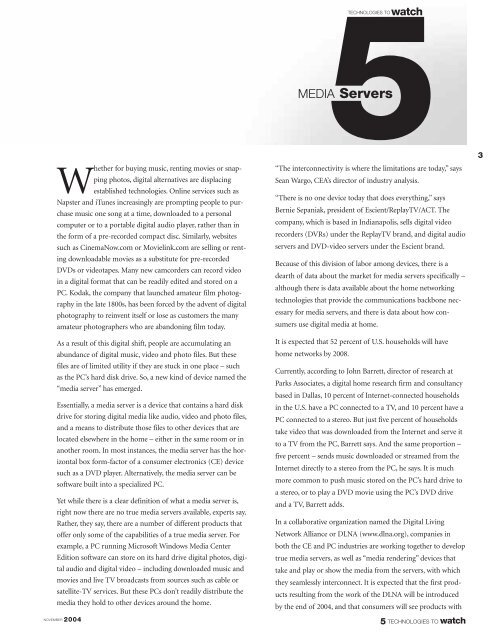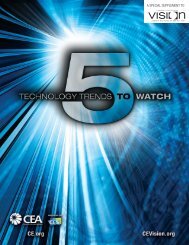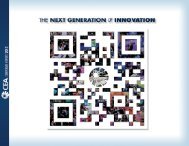TECHNOLOGIES TO watch - Consumer Electronics Association
TECHNOLOGIES TO watch - Consumer Electronics Association
TECHNOLOGIES TO watch - Consumer Electronics Association
You also want an ePaper? Increase the reach of your titles
YUMPU automatically turns print PDFs into web optimized ePapers that Google loves.
<strong>TECHNOLOGIES</strong> <strong>TO</strong><strong>watch</strong><br />
MEDIA Servers<br />
3<br />
Whether for buying music, renting movies or snapping<br />
photos, digital alternatives are displacing<br />
established technologies. Online services such as<br />
Napster and iTunes increasingly are prompting people to purchase<br />
music one song at a time, downloaded to a personal<br />
computer or to a portable digital audio player, rather than in<br />
the form of a pre-recorded compact disc. Similarly, websites<br />
such as CinemaNow.com or Movielink.com are selling or renting<br />
downloadable movies as a substitute for pre-recorded<br />
DVDs or videotapes. Many new camcorders can record video<br />
in a digital format that can be readily edited and stored on a<br />
PC. Kodak, the company that launched amateur film photography<br />
in the late 1800s, has been forced by the advent of digital<br />
photography to reinvent itself or lose as customers the many<br />
amateur photographers who are abandoning film today.<br />
As a result of this digital shift, people are accumulating an<br />
abundance of digital music, video and photo files. But these<br />
files are of limited utility if they are stuck in one place – such<br />
as the PC’s hard disk drive. So, a new kind of device named the<br />
“media server” has emerged.<br />
Essentially, a media server is a device that contains a hard disk<br />
drive for storing digital media like audio, video and photo files,<br />
and a means to distribute those files to other devices that are<br />
located elsewhere in the home – either in the same room or in<br />
another room. In most instances, the media server has the horizontal<br />
box form-factor of a consumer electronics (CE) device<br />
such as a DVD player. Alternatively, the media server can be<br />
software built into a specialized PC.<br />
Yet while there is a clear definition of what a media server is,<br />
right now there are no true media servers available, experts say.<br />
Rather, they say, there are a number of different products that<br />
offer only some of the capabilities of a true media server. For<br />
example, a PC running Microsoft Windows Media Center<br />
Edition software can store on its hard drive digital photos, digital<br />
audio and digital video – including downloaded music and<br />
movies and live TV broadcasts from sources such as cable or<br />
satellite-TV services. But these PCs don’t readily distribute the<br />
media they hold to other devices around the home.<br />
NOVEMBER 2004<br />
“The interconnectivity is where the limitations are today,” says<br />
Sean Wargo, CEA’s director of industry analysis.<br />
“There is no one device today that does everything,” says<br />
Bernie Sepaniak, president of Escient/ReplayTV/ACT. The<br />
company, which is based in Indianapolis, sells digital video<br />
recorders (DVRs) under the ReplayTV brand, and digital audio<br />
servers and DVD-video servers under the Escient brand.<br />
Because of this division of labor among devices, there is a<br />
dearth of data about the market for media servers specifically –<br />
although there is data available about the home networking<br />
technologies that provide the communications backbone necessary<br />
for media servers, and there is data about how consumers<br />
use digital media at home.<br />
It is expected that 52 percent of U.S. households will have<br />
home networks by 2008.<br />
Currently, according to John Barrett, director of research at<br />
Parks Associates, a digital home research firm and consultancy<br />
based in Dallas, 10 percent of Internet-connected households<br />
in the U.S. have a PC connected to a TV, and 10 percent have a<br />
PC connected to a stereo. But just five percent of households<br />
take video that was downloaded from the Internet and serve it<br />
to a TV from the PC, Barrett says. And the same proportion –<br />
five percent – sends music downloaded or streamed from the<br />
Internet directly to a stereo from the PC, he says. It is much<br />
more common to push music stored on the PC’s hard drive to<br />
a stereo, or to play a DVD movie using the PC’s DVD drive<br />
and a TV, Barrett adds.<br />
In a collaborative organization named the Digital Living<br />
Network Alliance or DLNA (www.dlna.org), companies in<br />
both the CE and PC industries are working together to develop<br />
true media servers, as well as “media rendering” devices that<br />
take and play or show the media from the servers, with which<br />
they seamlessly interconnect. It is expected that the first products<br />
resulting from the work of the DLNA will be introduced<br />
by the end of 2004, and that consumers will see products with<br />
5 <strong>TECHNOLOGIES</strong> <strong>TO</strong> <strong>watch</strong>










